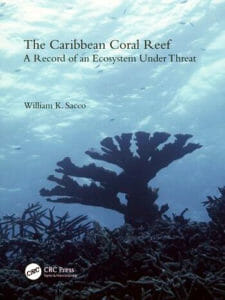Caribbean coral reefs, nature’s most endangered masterpiece, are shown at their prime in The Caribbean Coral Reef: A Record of an Ecosystem Under Threat, by William K. Sacco, 2023, CRC Press. These remarkable photos, taken in Jamaica, Panama, and Curaçao in the early 1970s, show the glory of the coral reef diversity 50 years ago before the deadly impacts of humans from garbage, sewage pollution, dredging, sedimentation, diseases, and global warming took a severe toll on them.

Caribbean coral reefs will never look this way again, most of these species, the most common in the healthiest reefs, are largely gone, with few if any survivors. These have been smothered by useless weeds proliferating from land-based sewage and fertilizer runoff. The only place now where we can see what we have lost all around the Caribbean is in this historic book. It shows a lost magical world.
This book belongs in the libraries of all individuals and libraries concerned about coral reefs, marine biodiversity, and threats to them from humans. It is especially important for Caribbean people, as the only place left they can see the incredibly rich world we have lost that used to line all of our coasts.
I began diving on the reefs shown some 20 years before these photos were taken, and there was little change in the reefs until then except locallized damage from dredging, shipwrecks and hurricanes. Bill Sacco’s photographs show almost all the major species in healthy Caribbean reefs before the major impacts of reef decline began to appear across the region.
Today reef like these remain only in small isolated patches in the most remote parts of the Caribbean, and while these remote sites are free of the gross pollution along all inhabited coasts, they are not immune to bleaching caused by global warming, nor to the new diseases caused by parasites introduced from outside. So even the last survivors are steadily dying back. In all the rest of the Caribbean almost all we see is weeds: weedy corals, but most of all weedy seaweeds, the ones that proliferate when over-ferrtilized by elevated nutrients in coastal waters from land-based sewage and fertilizers.
I continue to dive on these reefs today. Not only have most of the species shown in this book vanished at most sites, the survivors are largely sickly in appearance, and the most important large old habitat-building coral species have been replaced by small weedy species, whether corals or algae, with little habitat value. What is entirely missing in these photos is the massive overlay of these proliferating weeds now smothering reefs across the region today, we just didn’t see them in those days.
In this book you can see the entire Caribbean coral reef when it was intact, and learn of all the intricate relationships between them that made these coral reefs amazing oases of life and of beauty, the richest in biodiversity in all the Atlantic Ocean. Sadly, it will never be like this again, but although it is the first major ecosystem driven to functional exitinction by human pollution and climate change, it will not be the last unless the world acts immediately to reverse global climate change.
I’d like to add some personal observations about the author of this marvellous book. We first met in the the late 1960s, when he was being trained as a photographer by my grandfather, and again in the early 1970s, when he was setting out to the Discovery Bay Marine Laboratory in Jamaica, founded by my parents, where most of these photos were taken. Now you could cry to see the place. We remained in contact through the years, while he worked as the photographer at Yale University’s famous Peabody Museum of Natural History, documenting their treasures. As the years passed and the coral reefs continued to deteriorate, these old photos of how reefs used to be became more and more important. Bill began assembling this complete documentation of a rapidly vanishing ecosystem 20 years ago, only to find publishers were not interested because they did not see a commercial market for a book on the subject. He persisted after he retired. We must all be grateful that Bill persisted and that CRC Press has finally helped see this historical record of a lost world preserved for the public as it was in all its glory half a century ago.